Management and Operation: Leadership Roles and Functions Report
VerifiedAdded on 2020/02/03
|13
|4221
|114
Report
AI Summary
This report examines the management and operation functions within the Mark & Spencer company, a UK-based retailer. It compares different approaches to operations management, focusing on the roles and characteristics of leaders and managers. The report explores leadership theories such as contingency, trait, and behavioral theories, including situational leadership. It analyzes the application of these theories in various situations, emphasizing communication, planning, and problem-solving. Furthermore, the report delves into approaches to operations management, the importance of operations in achieving business objectives, and the impact of the business environment on operational decision-making. The report also discusses the functions of leaders and managers, their ability to identify problems and provide solutions. The report concludes by providing a comprehensive overview of leadership styles and management functions in a business context.
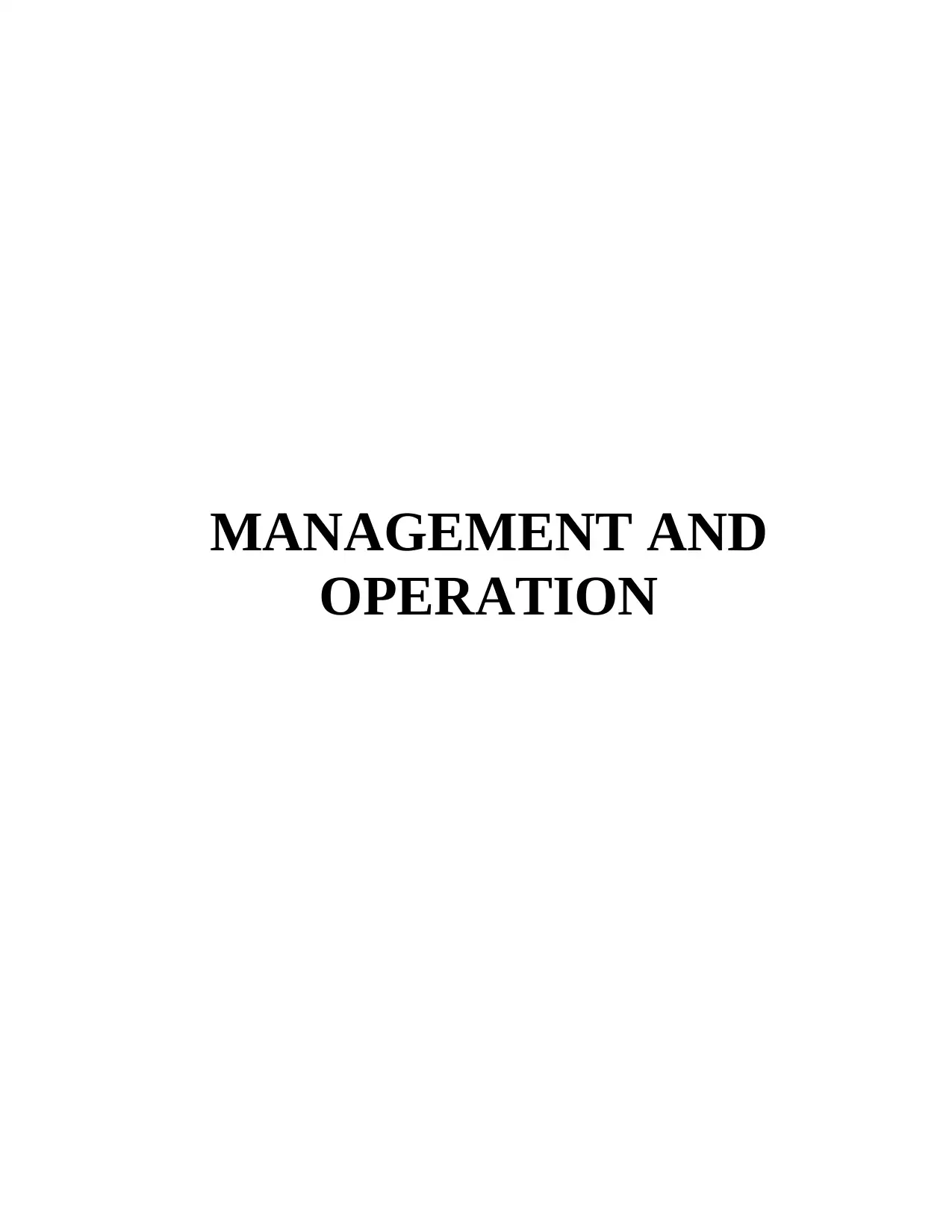
MANAGEMENT AND
OPERATION
OPERATION
Paraphrase This Document
Need a fresh take? Get an instant paraphrase of this document with our AI Paraphraser
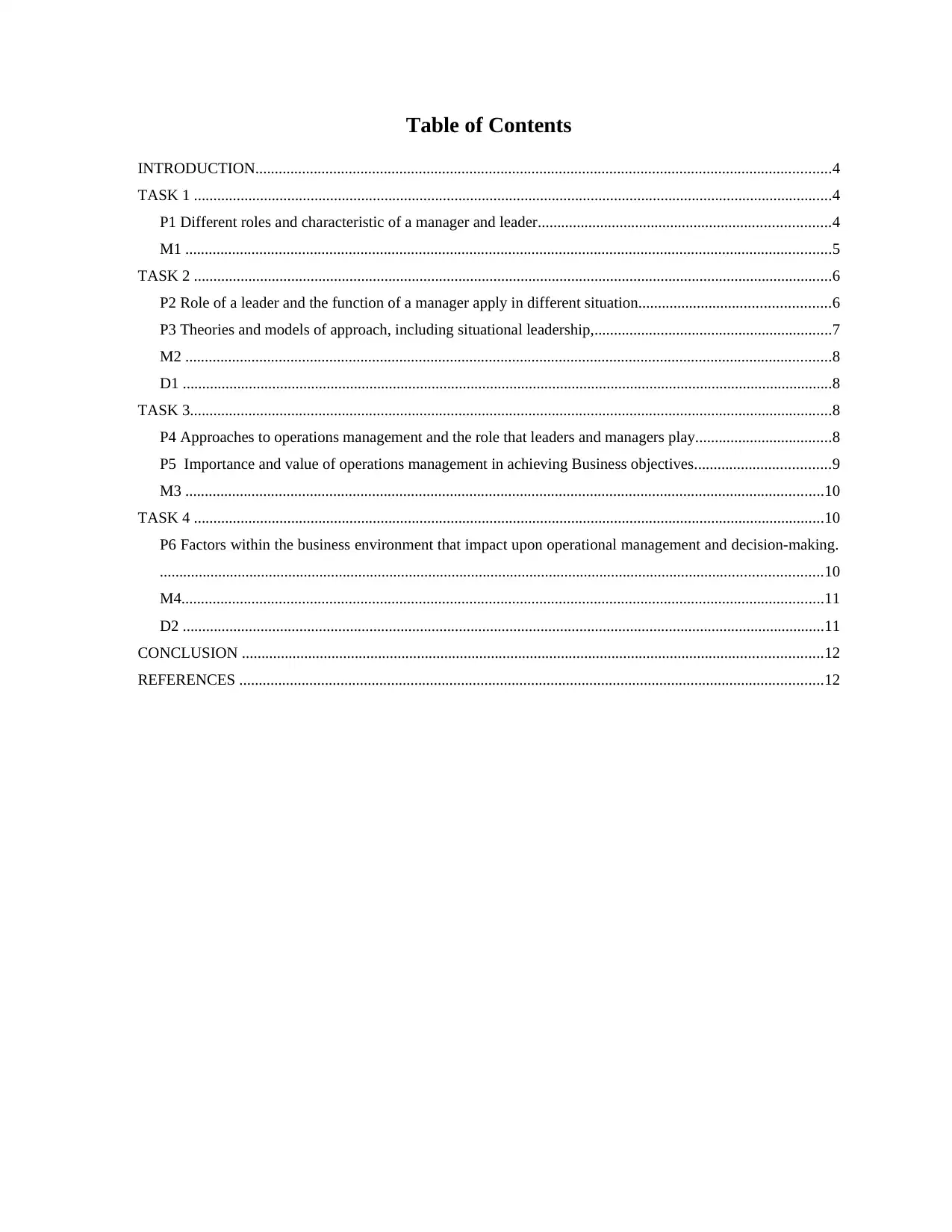
Table of Contents
INTRODUCTION....................................................................................................................................................4
TASK 1 ....................................................................................................................................................................4
P1 Different roles and characteristic of a manager and leader...........................................................................4
M1 ......................................................................................................................................................................5
TASK 2 ....................................................................................................................................................................6
P2 Role of a leader and the function of a manager apply in different situation.................................................6
P3 Theories and models of approach, including situational leadership,.............................................................7
M2 ......................................................................................................................................................................8
D1 .......................................................................................................................................................................8
TASK 3.....................................................................................................................................................................8
P4 Approaches to operations management and the role that leaders and managers play...................................8
P5 Importance and value of operations management in achieving Business objectives...................................9
M3 ....................................................................................................................................................................10
TASK 4 ..................................................................................................................................................................10
P6 Factors within the business environment that impact upon operational management and decision-making.
..........................................................................................................................................................................10
M4.....................................................................................................................................................................11
D2 .....................................................................................................................................................................11
CONCLUSION .....................................................................................................................................................12
REFERENCES ......................................................................................................................................................12
INTRODUCTION....................................................................................................................................................4
TASK 1 ....................................................................................................................................................................4
P1 Different roles and characteristic of a manager and leader...........................................................................4
M1 ......................................................................................................................................................................5
TASK 2 ....................................................................................................................................................................6
P2 Role of a leader and the function of a manager apply in different situation.................................................6
P3 Theories and models of approach, including situational leadership,.............................................................7
M2 ......................................................................................................................................................................8
D1 .......................................................................................................................................................................8
TASK 3.....................................................................................................................................................................8
P4 Approaches to operations management and the role that leaders and managers play...................................8
P5 Importance and value of operations management in achieving Business objectives...................................9
M3 ....................................................................................................................................................................10
TASK 4 ..................................................................................................................................................................10
P6 Factors within the business environment that impact upon operational management and decision-making.
..........................................................................................................................................................................10
M4.....................................................................................................................................................................11
D2 .....................................................................................................................................................................11
CONCLUSION .....................................................................................................................................................12
REFERENCES ......................................................................................................................................................12
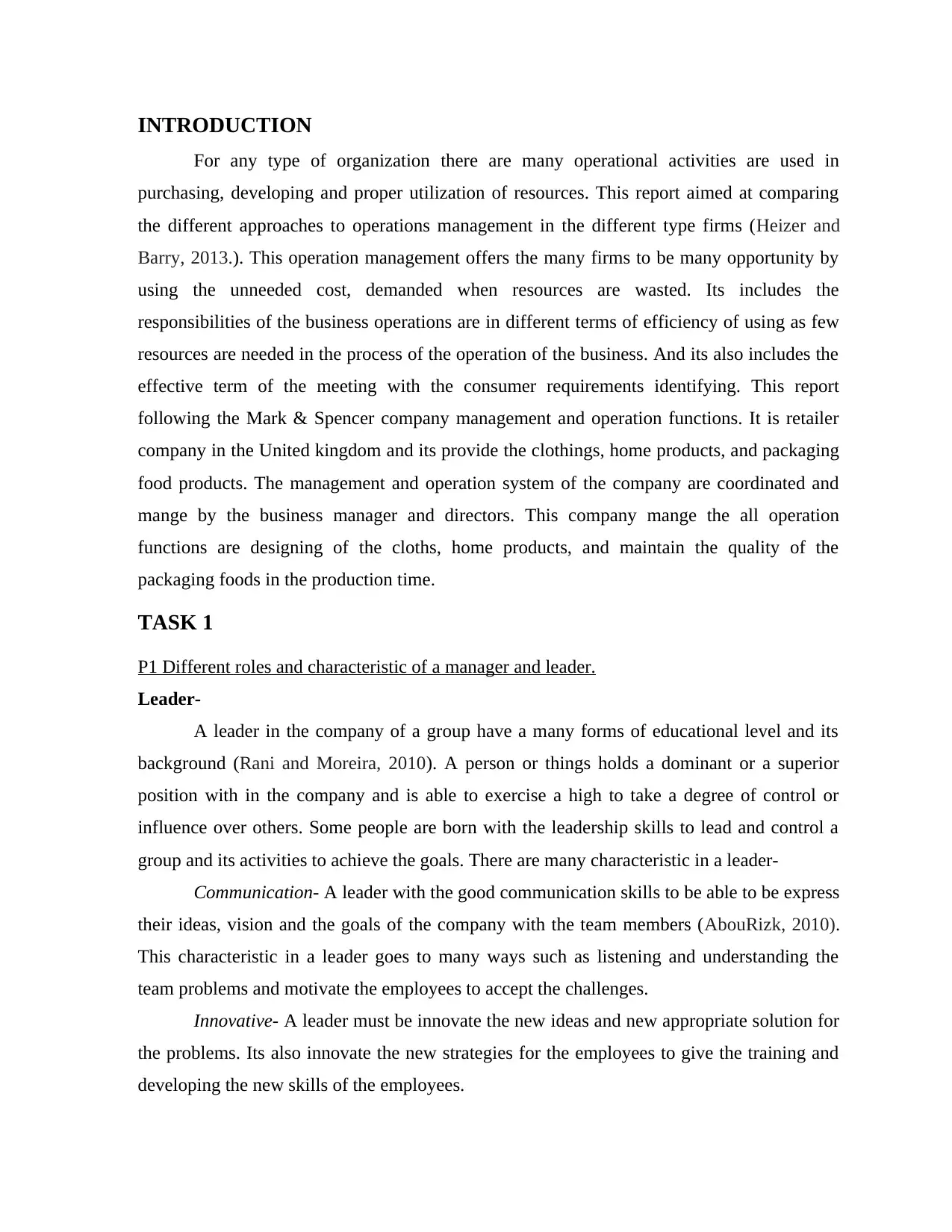
INTRODUCTION
For any type of organization there are many operational activities are used in
purchasing, developing and proper utilization of resources. This report aimed at comparing
the different approaches to operations management in the different type firms (Heizer and
Barry, 2013.). This operation management offers the many firms to be many opportunity by
using the unneeded cost, demanded when resources are wasted. Its includes the
responsibilities of the business operations are in different terms of efficiency of using as few
resources are needed in the process of the operation of the business. And its also includes the
effective term of the meeting with the consumer requirements identifying. This report
following the Mark & Spencer company management and operation functions. It is retailer
company in the United kingdom and its provide the clothings, home products, and packaging
food products. The management and operation system of the company are coordinated and
mange by the business manager and directors. This company mange the all operation
functions are designing of the cloths, home products, and maintain the quality of the
packaging foods in the production time.
TASK 1
P1 Different roles and characteristic of a manager and leader.
Leader-
A leader in the company of a group have a many forms of educational level and its
background (Rani and Moreira, 2010). A person or things holds a dominant or a superior
position with in the company and is able to exercise a high to take a degree of control or
influence over others. Some people are born with the leadership skills to lead and control a
group and its activities to achieve the goals. There are many characteristic in a leader-
Communication- A leader with the good communication skills to be able to be express
their ideas, vision and the goals of the company with the team members (AbouRizk, 2010).
This characteristic in a leader goes to many ways such as listening and understanding the
team problems and motivate the employees to accept the challenges.
Innovative- A leader must be innovate the new ideas and new appropriate solution for
the problems. Its also innovate the new strategies for the employees to give the training and
developing the new skills of the employees.
For any type of organization there are many operational activities are used in
purchasing, developing and proper utilization of resources. This report aimed at comparing
the different approaches to operations management in the different type firms (Heizer and
Barry, 2013.). This operation management offers the many firms to be many opportunity by
using the unneeded cost, demanded when resources are wasted. Its includes the
responsibilities of the business operations are in different terms of efficiency of using as few
resources are needed in the process of the operation of the business. And its also includes the
effective term of the meeting with the consumer requirements identifying. This report
following the Mark & Spencer company management and operation functions. It is retailer
company in the United kingdom and its provide the clothings, home products, and packaging
food products. The management and operation system of the company are coordinated and
mange by the business manager and directors. This company mange the all operation
functions are designing of the cloths, home products, and maintain the quality of the
packaging foods in the production time.
TASK 1
P1 Different roles and characteristic of a manager and leader.
Leader-
A leader in the company of a group have a many forms of educational level and its
background (Rani and Moreira, 2010). A person or things holds a dominant or a superior
position with in the company and is able to exercise a high to take a degree of control or
influence over others. Some people are born with the leadership skills to lead and control a
group and its activities to achieve the goals. There are many characteristic in a leader-
Communication- A leader with the good communication skills to be able to be express
their ideas, vision and the goals of the company with the team members (AbouRizk, 2010).
This characteristic in a leader goes to many ways such as listening and understanding the
team problems and motivate the employees to accept the challenges.
Innovative- A leader must be innovate the new ideas and new appropriate solution for
the problems. Its also innovate the new strategies for the employees to give the training and
developing the new skills of the employees.
⊘ This is a preview!⊘
Do you want full access?
Subscribe today to unlock all pages.

Trusted by 1+ million students worldwide
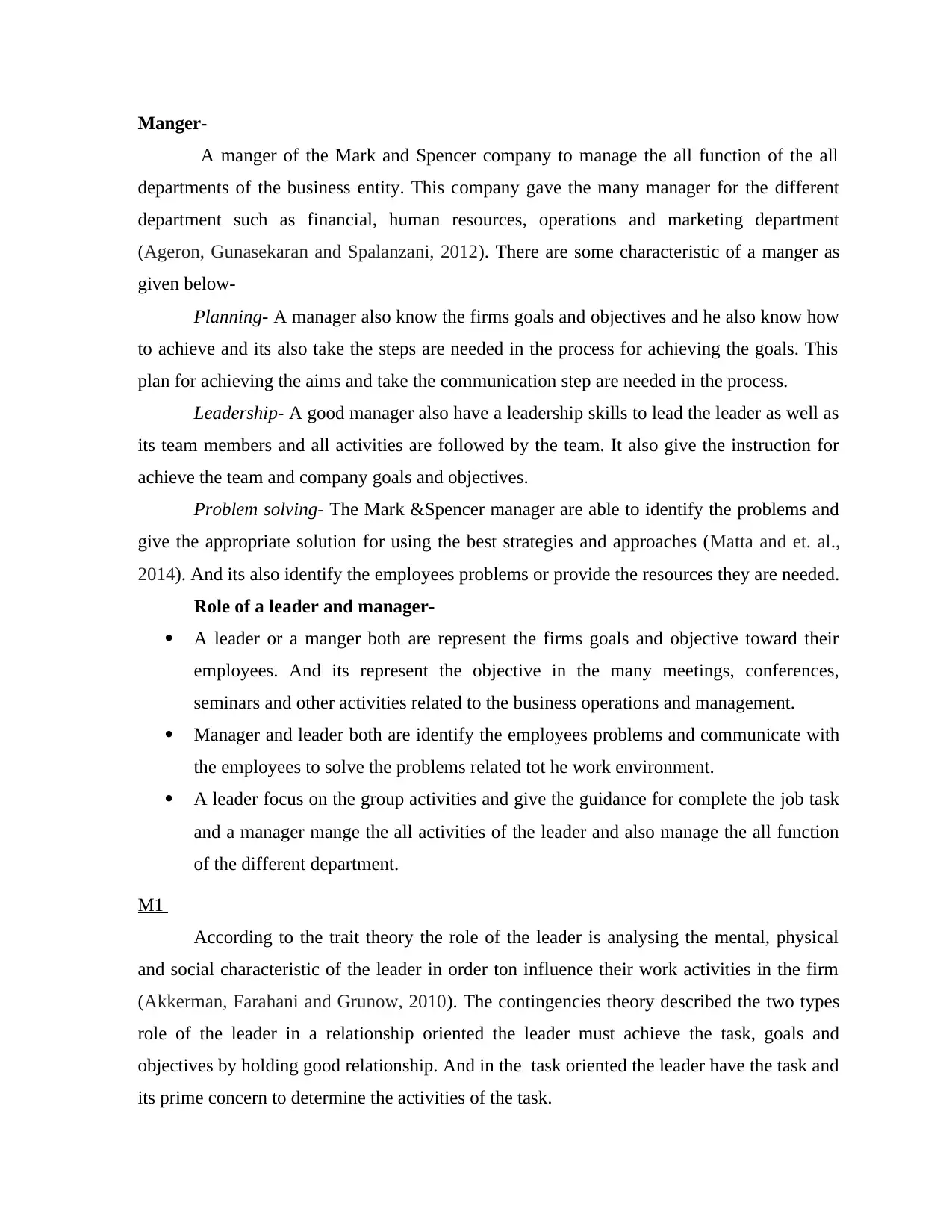
Manger-
A manger of the Mark and Spencer company to manage the all function of the all
departments of the business entity. This company gave the many manager for the different
department such as financial, human resources, operations and marketing department
(Ageron, Gunasekaran and Spalanzani, 2012). There are some characteristic of a manger as
given below-
Planning- A manager also know the firms goals and objectives and he also know how
to achieve and its also take the steps are needed in the process for achieving the goals. This
plan for achieving the aims and take the communication step are needed in the process.
Leadership- A good manager also have a leadership skills to lead the leader as well as
its team members and all activities are followed by the team. It also give the instruction for
achieve the team and company goals and objectives.
Problem solving- The Mark &Spencer manager are able to identify the problems and
give the appropriate solution for using the best strategies and approaches (Matta and et. al.,
2014). And its also identify the employees problems or provide the resources they are needed.
Role of a leader and manager-
A leader or a manger both are represent the firms goals and objective toward their
employees. And its represent the objective in the many meetings, conferences,
seminars and other activities related to the business operations and management.
Manager and leader both are identify the employees problems and communicate with
the employees to solve the problems related tot he work environment.
A leader focus on the group activities and give the guidance for complete the job task
and a manager mange the all activities of the leader and also manage the all function
of the different department.
M1
According to the trait theory the role of the leader is analysing the mental, physical
and social characteristic of the leader in order ton influence their work activities in the firm
(Akkerman, Farahani and Grunow, 2010). The contingencies theory described the two types
role of the leader in a relationship oriented the leader must achieve the task, goals and
objectives by holding good relationship. And in the task oriented the leader have the task and
its prime concern to determine the activities of the task.
A manger of the Mark and Spencer company to manage the all function of the all
departments of the business entity. This company gave the many manager for the different
department such as financial, human resources, operations and marketing department
(Ageron, Gunasekaran and Spalanzani, 2012). There are some characteristic of a manger as
given below-
Planning- A manager also know the firms goals and objectives and he also know how
to achieve and its also take the steps are needed in the process for achieving the goals. This
plan for achieving the aims and take the communication step are needed in the process.
Leadership- A good manager also have a leadership skills to lead the leader as well as
its team members and all activities are followed by the team. It also give the instruction for
achieve the team and company goals and objectives.
Problem solving- The Mark &Spencer manager are able to identify the problems and
give the appropriate solution for using the best strategies and approaches (Matta and et. al.,
2014). And its also identify the employees problems or provide the resources they are needed.
Role of a leader and manager-
A leader or a manger both are represent the firms goals and objective toward their
employees. And its represent the objective in the many meetings, conferences,
seminars and other activities related to the business operations and management.
Manager and leader both are identify the employees problems and communicate with
the employees to solve the problems related tot he work environment.
A leader focus on the group activities and give the guidance for complete the job task
and a manager mange the all activities of the leader and also manage the all function
of the different department.
M1
According to the trait theory the role of the leader is analysing the mental, physical
and social characteristic of the leader in order ton influence their work activities in the firm
(Akkerman, Farahani and Grunow, 2010). The contingencies theory described the two types
role of the leader in a relationship oriented the leader must achieve the task, goals and
objectives by holding good relationship. And in the task oriented the leader have the task and
its prime concern to determine the activities of the task.
Paraphrase This Document
Need a fresh take? Get an instant paraphrase of this document with our AI Paraphraser
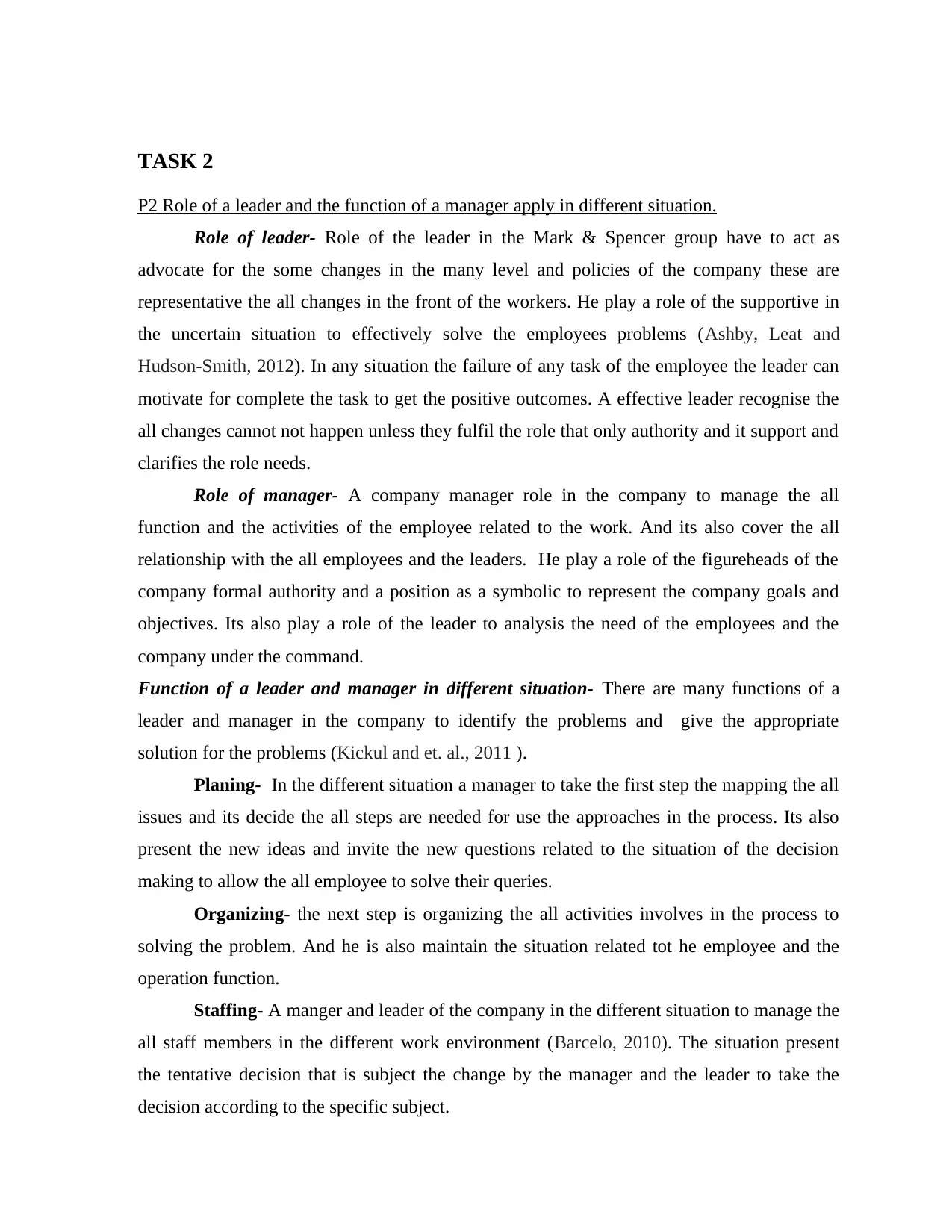
TASK 2
P2 Role of a leader and the function of a manager apply in different situation.
Role of leader- Role of the leader in the Mark & Spencer group have to act as
advocate for the some changes in the many level and policies of the company these are
representative the all changes in the front of the workers. He play a role of the supportive in
the uncertain situation to effectively solve the employees problems (Ashby, Leat and
Hudson-Smith, 2012). In any situation the failure of any task of the employee the leader can
motivate for complete the task to get the positive outcomes. A effective leader recognise the
all changes cannot not happen unless they fulfil the role that only authority and it support and
clarifies the role needs.
Role of manager- A company manager role in the company to manage the all
function and the activities of the employee related to the work. And its also cover the all
relationship with the all employees and the leaders. He play a role of the figureheads of the
company formal authority and a position as a symbolic to represent the company goals and
objectives. Its also play a role of the leader to analysis the need of the employees and the
company under the command.
Function of a leader and manager in different situation- There are many functions of a
leader and manager in the company to identify the problems and give the appropriate
solution for the problems (Kickul and et. al., 2011 ).
Planing- In the different situation a manager to take the first step the mapping the all
issues and its decide the all steps are needed for use the approaches in the process. Its also
present the new ideas and invite the new questions related to the situation of the decision
making to allow the all employee to solve their queries.
Organizing- the next step is organizing the all activities involves in the process to
solving the problem. And he is also maintain the situation related tot he employee and the
operation function.
Staffing- A manger and leader of the company in the different situation to manage the
all staff members in the different work environment (Barcelo, 2010). The situation present
the tentative decision that is subject the change by the manager and the leader to take the
decision according to the specific subject.
P2 Role of a leader and the function of a manager apply in different situation.
Role of leader- Role of the leader in the Mark & Spencer group have to act as
advocate for the some changes in the many level and policies of the company these are
representative the all changes in the front of the workers. He play a role of the supportive in
the uncertain situation to effectively solve the employees problems (Ashby, Leat and
Hudson-Smith, 2012). In any situation the failure of any task of the employee the leader can
motivate for complete the task to get the positive outcomes. A effective leader recognise the
all changes cannot not happen unless they fulfil the role that only authority and it support and
clarifies the role needs.
Role of manager- A company manager role in the company to manage the all
function and the activities of the employee related to the work. And its also cover the all
relationship with the all employees and the leaders. He play a role of the figureheads of the
company formal authority and a position as a symbolic to represent the company goals and
objectives. Its also play a role of the leader to analysis the need of the employees and the
company under the command.
Function of a leader and manager in different situation- There are many functions of a
leader and manager in the company to identify the problems and give the appropriate
solution for the problems (Kickul and et. al., 2011 ).
Planing- In the different situation a manager to take the first step the mapping the all
issues and its decide the all steps are needed for use the approaches in the process. Its also
present the new ideas and invite the new questions related to the situation of the decision
making to allow the all employee to solve their queries.
Organizing- the next step is organizing the all activities involves in the process to
solving the problem. And he is also maintain the situation related tot he employee and the
operation function.
Staffing- A manger and leader of the company in the different situation to manage the
all staff members in the different work environment (Barcelo, 2010). The situation present
the tentative decision that is subject the change by the manager and the leader to take the
decision according to the specific subject.
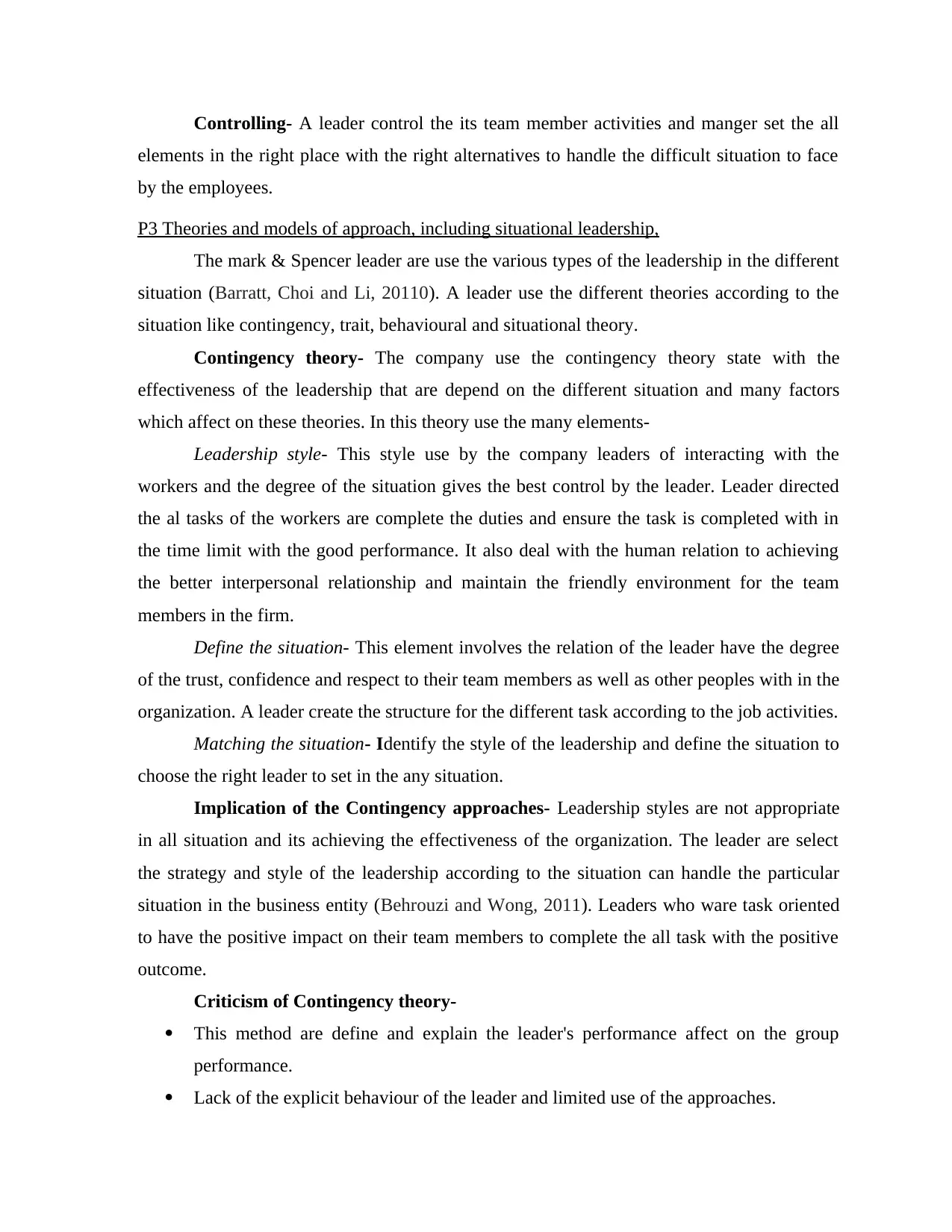
Controlling- A leader control the its team member activities and manger set the all
elements in the right place with the right alternatives to handle the difficult situation to face
by the employees.
P3 Theories and models of approach, including situational leadership,
The mark & Spencer leader are use the various types of the leadership in the different
situation (Barratt, Choi and Li, 20110). A leader use the different theories according to the
situation like contingency, trait, behavioural and situational theory.
Contingency theory- The company use the contingency theory state with the
effectiveness of the leadership that are depend on the different situation and many factors
which affect on these theories. In this theory use the many elements-
Leadership style- This style use by the company leaders of interacting with the
workers and the degree of the situation gives the best control by the leader. Leader directed
the al tasks of the workers are complete the duties and ensure the task is completed with in
the time limit with the good performance. It also deal with the human relation to achieving
the better interpersonal relationship and maintain the friendly environment for the team
members in the firm.
Define the situation- This element involves the relation of the leader have the degree
of the trust, confidence and respect to their team members as well as other peoples with in the
organization. A leader create the structure for the different task according to the job activities.
Matching the situation- Identify the style of the leadership and define the situation to
choose the right leader to set in the any situation.
Implication of the Contingency approaches- Leadership styles are not appropriate
in all situation and its achieving the effectiveness of the organization. The leader are select
the strategy and style of the leadership according to the situation can handle the particular
situation in the business entity (Behrouzi and Wong, 2011). Leaders who ware task oriented
to have the positive impact on their team members to complete the all task with the positive
outcome.
Criticism of Contingency theory-
This method are define and explain the leader's performance affect on the group
performance.
Lack of the explicit behaviour of the leader and limited use of the approaches.
elements in the right place with the right alternatives to handle the difficult situation to face
by the employees.
P3 Theories and models of approach, including situational leadership,
The mark & Spencer leader are use the various types of the leadership in the different
situation (Barratt, Choi and Li, 20110). A leader use the different theories according to the
situation like contingency, trait, behavioural and situational theory.
Contingency theory- The company use the contingency theory state with the
effectiveness of the leadership that are depend on the different situation and many factors
which affect on these theories. In this theory use the many elements-
Leadership style- This style use by the company leaders of interacting with the
workers and the degree of the situation gives the best control by the leader. Leader directed
the al tasks of the workers are complete the duties and ensure the task is completed with in
the time limit with the good performance. It also deal with the human relation to achieving
the better interpersonal relationship and maintain the friendly environment for the team
members in the firm.
Define the situation- This element involves the relation of the leader have the degree
of the trust, confidence and respect to their team members as well as other peoples with in the
organization. A leader create the structure for the different task according to the job activities.
Matching the situation- Identify the style of the leadership and define the situation to
choose the right leader to set in the any situation.
Implication of the Contingency approaches- Leadership styles are not appropriate
in all situation and its achieving the effectiveness of the organization. The leader are select
the strategy and style of the leadership according to the situation can handle the particular
situation in the business entity (Behrouzi and Wong, 2011). Leaders who ware task oriented
to have the positive impact on their team members to complete the all task with the positive
outcome.
Criticism of Contingency theory-
This method are define and explain the leader's performance affect on the group
performance.
Lack of the explicit behaviour of the leader and limited use of the approaches.
⊘ This is a preview!⊘
Do you want full access?
Subscribe today to unlock all pages.

Trusted by 1+ million students worldwide
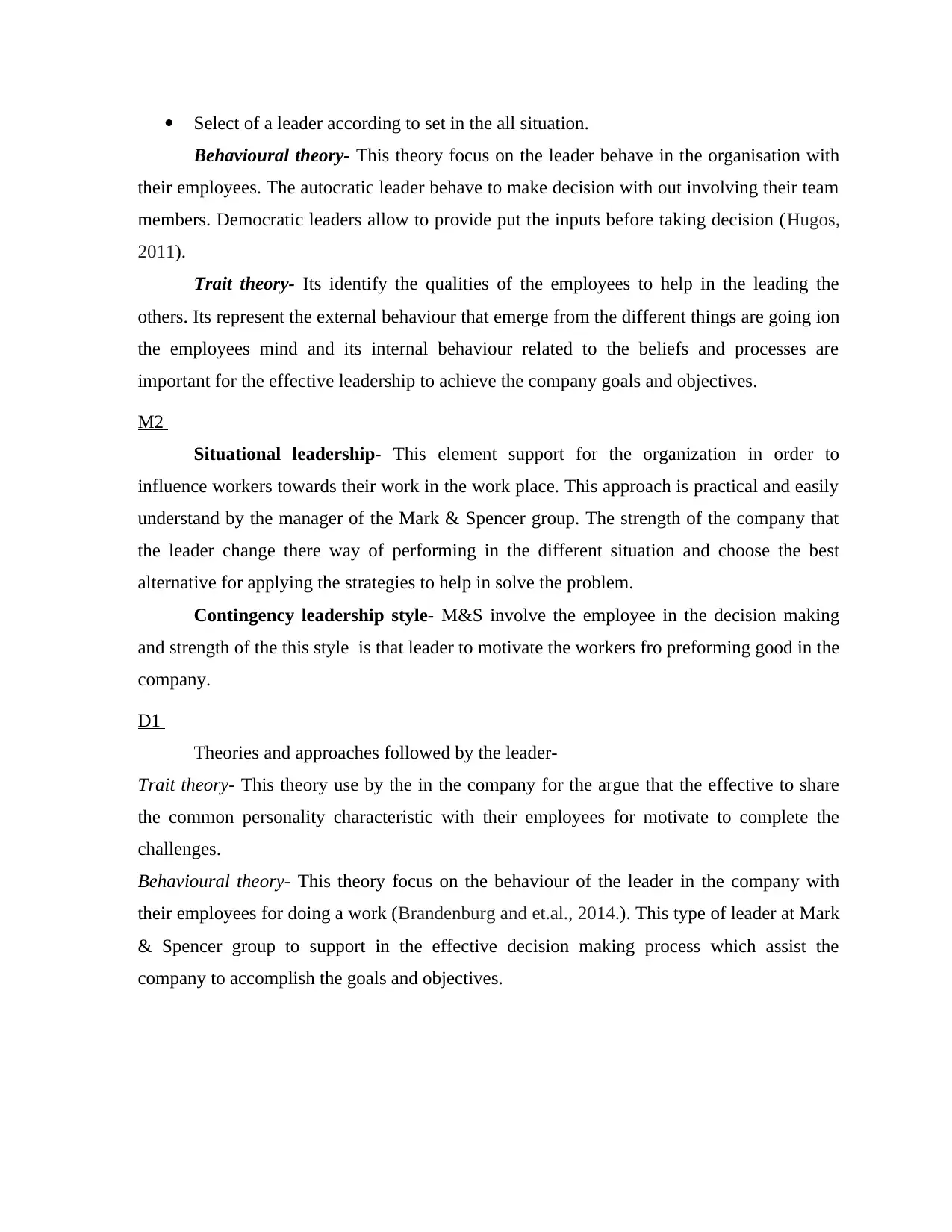
Select of a leader according to set in the all situation.
Behavioural theory- This theory focus on the leader behave in the organisation with
their employees. The autocratic leader behave to make decision with out involving their team
members. Democratic leaders allow to provide put the inputs before taking decision (Hugos,
2011).
Trait theory- Its identify the qualities of the employees to help in the leading the
others. Its represent the external behaviour that emerge from the different things are going ion
the employees mind and its internal behaviour related to the beliefs and processes are
important for the effective leadership to achieve the company goals and objectives.
M2
Situational leadership- This element support for the organization in order to
influence workers towards their work in the work place. This approach is practical and easily
understand by the manager of the Mark & Spencer group. The strength of the company that
the leader change there way of performing in the different situation and choose the best
alternative for applying the strategies to help in solve the problem.
Contingency leadership style- M&S involve the employee in the decision making
and strength of the this style is that leader to motivate the workers fro preforming good in the
company.
D1
Theories and approaches followed by the leader-
Trait theory- This theory use by the in the company for the argue that the effective to share
the common personality characteristic with their employees for motivate to complete the
challenges.
Behavioural theory- This theory focus on the behaviour of the leader in the company with
their employees for doing a work (Brandenburg and et.al., 2014.). This type of leader at Mark
& Spencer group to support in the effective decision making process which assist the
company to accomplish the goals and objectives.
Behavioural theory- This theory focus on the leader behave in the organisation with
their employees. The autocratic leader behave to make decision with out involving their team
members. Democratic leaders allow to provide put the inputs before taking decision (Hugos,
2011).
Trait theory- Its identify the qualities of the employees to help in the leading the
others. Its represent the external behaviour that emerge from the different things are going ion
the employees mind and its internal behaviour related to the beliefs and processes are
important for the effective leadership to achieve the company goals and objectives.
M2
Situational leadership- This element support for the organization in order to
influence workers towards their work in the work place. This approach is practical and easily
understand by the manager of the Mark & Spencer group. The strength of the company that
the leader change there way of performing in the different situation and choose the best
alternative for applying the strategies to help in solve the problem.
Contingency leadership style- M&S involve the employee in the decision making
and strength of the this style is that leader to motivate the workers fro preforming good in the
company.
D1
Theories and approaches followed by the leader-
Trait theory- This theory use by the in the company for the argue that the effective to share
the common personality characteristic with their employees for motivate to complete the
challenges.
Behavioural theory- This theory focus on the behaviour of the leader in the company with
their employees for doing a work (Brandenburg and et.al., 2014.). This type of leader at Mark
& Spencer group to support in the effective decision making process which assist the
company to accomplish the goals and objectives.
Paraphrase This Document
Need a fresh take? Get an instant paraphrase of this document with our AI Paraphraser
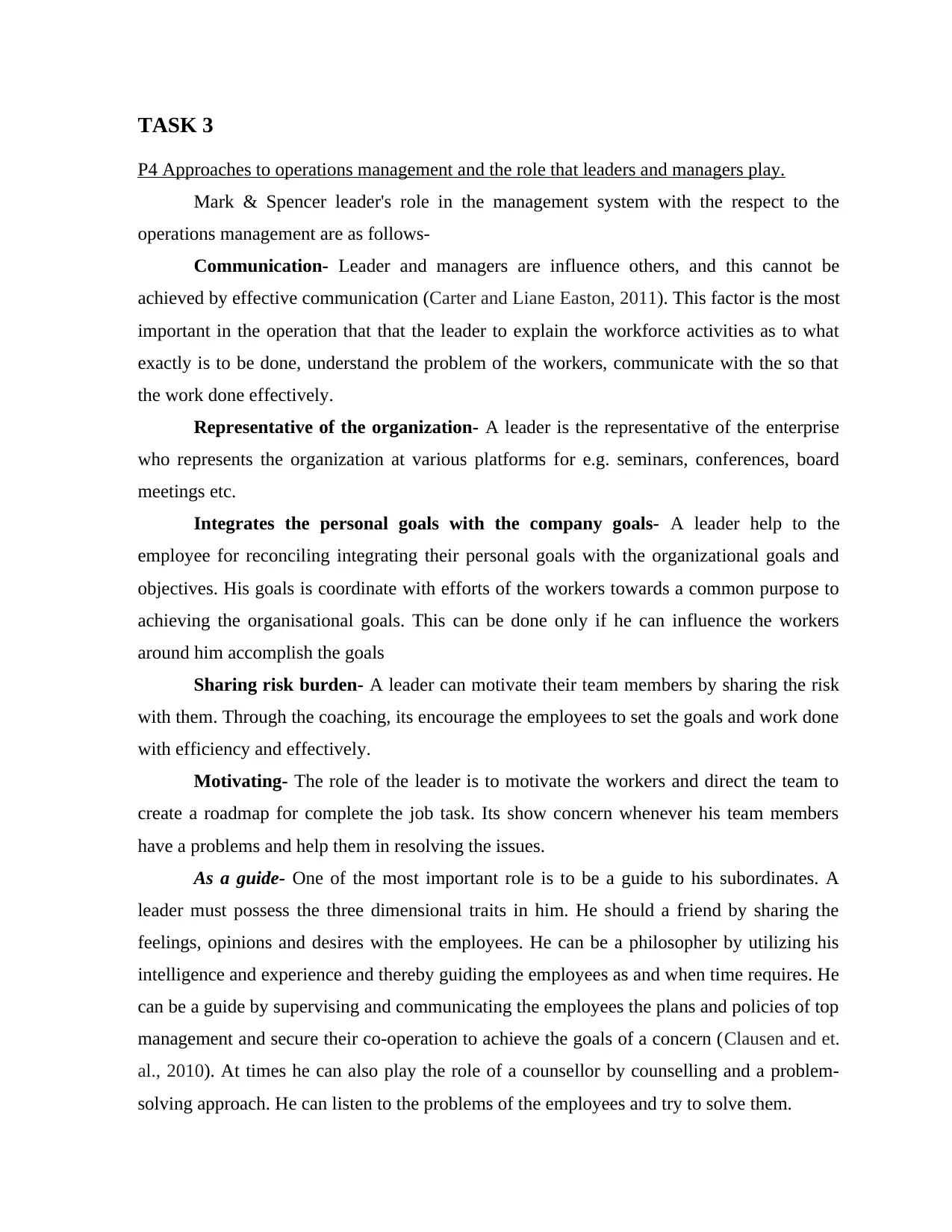
TASK 3
P4 Approaches to operations management and the role that leaders and managers play.
Mark & Spencer leader's role in the management system with the respect to the
operations management are as follows-
Communication- Leader and managers are influence others, and this cannot be
achieved by effective communication (Carter and Liane Easton, 2011). This factor is the most
important in the operation that that the leader to explain the workforce activities as to what
exactly is to be done, understand the problem of the workers, communicate with the so that
the work done effectively.
Representative of the organization- A leader is the representative of the enterprise
who represents the organization at various platforms for e.g. seminars, conferences, board
meetings etc.
Integrates the personal goals with the company goals- A leader help to the
employee for reconciling integrating their personal goals with the organizational goals and
objectives. His goals is coordinate with efforts of the workers towards a common purpose to
achieving the organisational goals. This can be done only if he can influence the workers
around him accomplish the goals
Sharing risk burden- A leader can motivate their team members by sharing the risk
with them. Through the coaching, its encourage the employees to set the goals and work done
with efficiency and effectively.
Motivating- The role of the leader is to motivate the workers and direct the team to
create a roadmap for complete the job task. Its show concern whenever his team members
have a problems and help them in resolving the issues.
As a guide- One of the most important role is to be a guide to his subordinates. A
leader must possess the three dimensional traits in him. He should a friend by sharing the
feelings, opinions and desires with the employees. He can be a philosopher by utilizing his
intelligence and experience and thereby guiding the employees as and when time requires. He
can be a guide by supervising and communicating the employees the plans and policies of top
management and secure their co-operation to achieve the goals of a concern (Clausen and et.
al., 2010). At times he can also play the role of a counsellor by counselling and a problem-
solving approach. He can listen to the problems of the employees and try to solve them.
P4 Approaches to operations management and the role that leaders and managers play.
Mark & Spencer leader's role in the management system with the respect to the
operations management are as follows-
Communication- Leader and managers are influence others, and this cannot be
achieved by effective communication (Carter and Liane Easton, 2011). This factor is the most
important in the operation that that the leader to explain the workforce activities as to what
exactly is to be done, understand the problem of the workers, communicate with the so that
the work done effectively.
Representative of the organization- A leader is the representative of the enterprise
who represents the organization at various platforms for e.g. seminars, conferences, board
meetings etc.
Integrates the personal goals with the company goals- A leader help to the
employee for reconciling integrating their personal goals with the organizational goals and
objectives. His goals is coordinate with efforts of the workers towards a common purpose to
achieving the organisational goals. This can be done only if he can influence the workers
around him accomplish the goals
Sharing risk burden- A leader can motivate their team members by sharing the risk
with them. Through the coaching, its encourage the employees to set the goals and work done
with efficiency and effectively.
Motivating- The role of the leader is to motivate the workers and direct the team to
create a roadmap for complete the job task. Its show concern whenever his team members
have a problems and help them in resolving the issues.
As a guide- One of the most important role is to be a guide to his subordinates. A
leader must possess the three dimensional traits in him. He should a friend by sharing the
feelings, opinions and desires with the employees. He can be a philosopher by utilizing his
intelligence and experience and thereby guiding the employees as and when time requires. He
can be a guide by supervising and communicating the employees the plans and policies of top
management and secure their co-operation to achieve the goals of a concern (Clausen and et.
al., 2010). At times he can also play the role of a counsellor by counselling and a problem-
solving approach. He can listen to the problems of the employees and try to solve them.
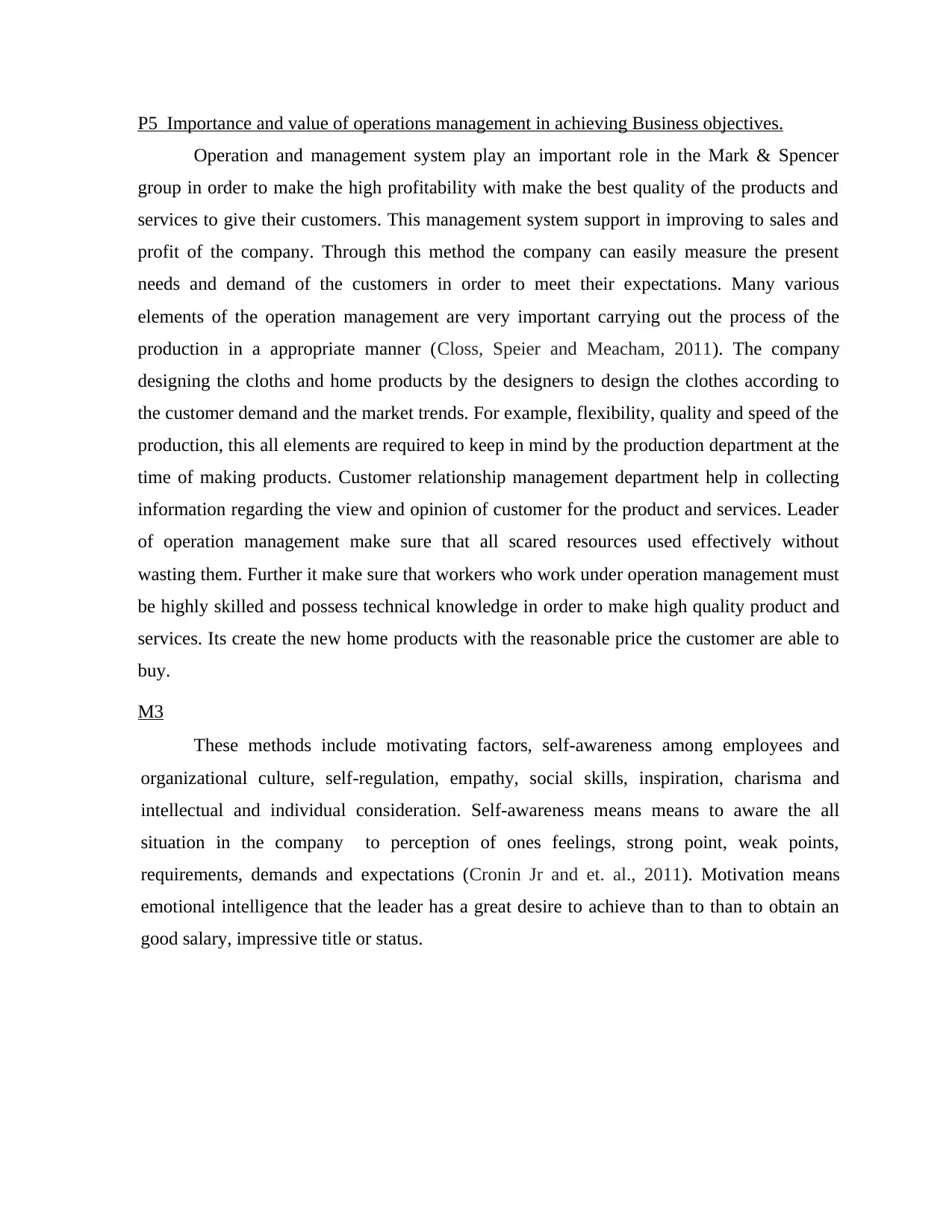
P5 Importance and value of operations management in achieving Business objectives.
Operation and management system play an important role in the Mark & Spencer
group in order to make the high profitability with make the best quality of the products and
services to give their customers. This management system support in improving to sales and
profit of the company. Through this method the company can easily measure the present
needs and demand of the customers in order to meet their expectations. Many various
elements of the operation management are very important carrying out the process of the
production in a appropriate manner (Closs, Speier and Meacham, 2011). The company
designing the cloths and home products by the designers to design the clothes according to
the customer demand and the market trends. For example, flexibility, quality and speed of the
production, this all elements are required to keep in mind by the production department at the
time of making products. Customer relationship management department help in collecting
information regarding the view and opinion of customer for the product and services. Leader
of operation management make sure that all scared resources used effectively without
wasting them. Further it make sure that workers who work under operation management must
be highly skilled and possess technical knowledge in order to make high quality product and
services. Its create the new home products with the reasonable price the customer are able to
buy.
M3
These methods include motivating factors, self-awareness among employees and
organizational culture, self-regulation, empathy, social skills, inspiration, charisma and
intellectual and individual consideration. Self-awareness means means to aware the all
situation in the company to perception of ones feelings, strong point, weak points,
requirements, demands and expectations (Cronin Jr and et. al., 2011). Motivation means
emotional intelligence that the leader has a great desire to achieve than to than to obtain an
good salary, impressive title or status.
Operation and management system play an important role in the Mark & Spencer
group in order to make the high profitability with make the best quality of the products and
services to give their customers. This management system support in improving to sales and
profit of the company. Through this method the company can easily measure the present
needs and demand of the customers in order to meet their expectations. Many various
elements of the operation management are very important carrying out the process of the
production in a appropriate manner (Closs, Speier and Meacham, 2011). The company
designing the cloths and home products by the designers to design the clothes according to
the customer demand and the market trends. For example, flexibility, quality and speed of the
production, this all elements are required to keep in mind by the production department at the
time of making products. Customer relationship management department help in collecting
information regarding the view and opinion of customer for the product and services. Leader
of operation management make sure that all scared resources used effectively without
wasting them. Further it make sure that workers who work under operation management must
be highly skilled and possess technical knowledge in order to make high quality product and
services. Its create the new home products with the reasonable price the customer are able to
buy.
M3
These methods include motivating factors, self-awareness among employees and
organizational culture, self-regulation, empathy, social skills, inspiration, charisma and
intellectual and individual consideration. Self-awareness means means to aware the all
situation in the company to perception of ones feelings, strong point, weak points,
requirements, demands and expectations (Cronin Jr and et. al., 2011). Motivation means
emotional intelligence that the leader has a great desire to achieve than to than to obtain an
good salary, impressive title or status.
⊘ This is a preview!⊘
Do you want full access?
Subscribe today to unlock all pages.

Trusted by 1+ million students worldwide
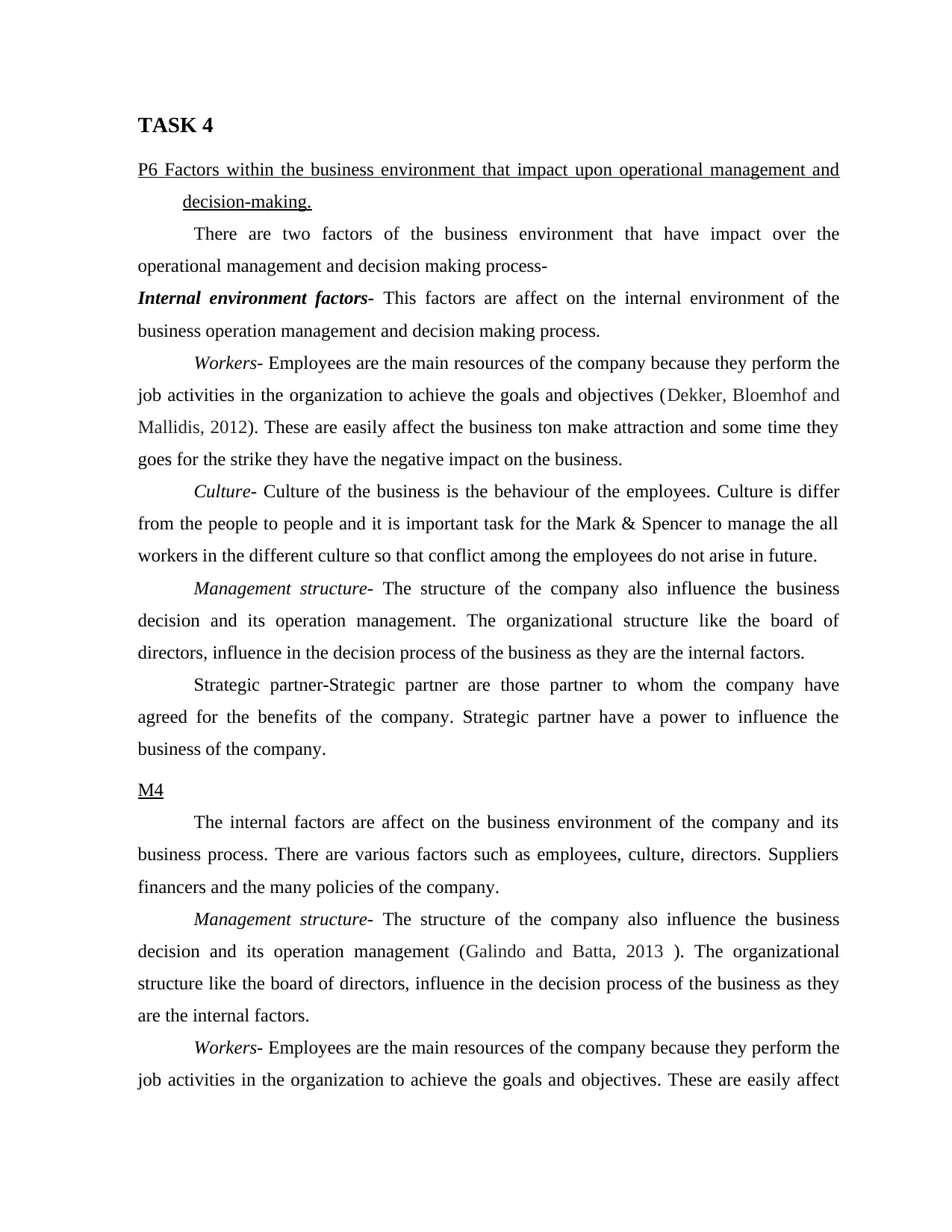
TASK 4
P6 Factors within the business environment that impact upon operational management and
decision-making.
There are two factors of the business environment that have impact over the
operational management and decision making process-
Internal environment factors- This factors are affect on the internal environment of the
business operation management and decision making process.
Workers- Employees are the main resources of the company because they perform the
job activities in the organization to achieve the goals and objectives (Dekker, Bloemhof and
Mallidis, 2012). These are easily affect the business ton make attraction and some time they
goes for the strike they have the negative impact on the business.
Culture- Culture of the business is the behaviour of the employees. Culture is differ
from the people to people and it is important task for the Mark & Spencer to manage the all
workers in the different culture so that conflict among the employees do not arise in future.
Management structure- The structure of the company also influence the business
decision and its operation management. The organizational structure like the board of
directors, influence in the decision process of the business as they are the internal factors.
Strategic partner-Strategic partner are those partner to whom the company have
agreed for the benefits of the company. Strategic partner have a power to influence the
business of the company.
M4
The internal factors are affect on the business environment of the company and its
business process. There are various factors such as employees, culture, directors. Suppliers
financers and the many policies of the company.
Management structure- The structure of the company also influence the business
decision and its operation management (Galindo and Batta, 2013 ). The organizational
structure like the board of directors, influence in the decision process of the business as they
are the internal factors.
Workers- Employees are the main resources of the company because they perform the
job activities in the organization to achieve the goals and objectives. These are easily affect
P6 Factors within the business environment that impact upon operational management and
decision-making.
There are two factors of the business environment that have impact over the
operational management and decision making process-
Internal environment factors- This factors are affect on the internal environment of the
business operation management and decision making process.
Workers- Employees are the main resources of the company because they perform the
job activities in the organization to achieve the goals and objectives (Dekker, Bloemhof and
Mallidis, 2012). These are easily affect the business ton make attraction and some time they
goes for the strike they have the negative impact on the business.
Culture- Culture of the business is the behaviour of the employees. Culture is differ
from the people to people and it is important task for the Mark & Spencer to manage the all
workers in the different culture so that conflict among the employees do not arise in future.
Management structure- The structure of the company also influence the business
decision and its operation management. The organizational structure like the board of
directors, influence in the decision process of the business as they are the internal factors.
Strategic partner-Strategic partner are those partner to whom the company have
agreed for the benefits of the company. Strategic partner have a power to influence the
business of the company.
M4
The internal factors are affect on the business environment of the company and its
business process. There are various factors such as employees, culture, directors. Suppliers
financers and the many policies of the company.
Management structure- The structure of the company also influence the business
decision and its operation management (Galindo and Batta, 2013 ). The organizational
structure like the board of directors, influence in the decision process of the business as they
are the internal factors.
Workers- Employees are the main resources of the company because they perform the
job activities in the organization to achieve the goals and objectives. These are easily affect
Paraphrase This Document
Need a fresh take? Get an instant paraphrase of this document with our AI Paraphraser
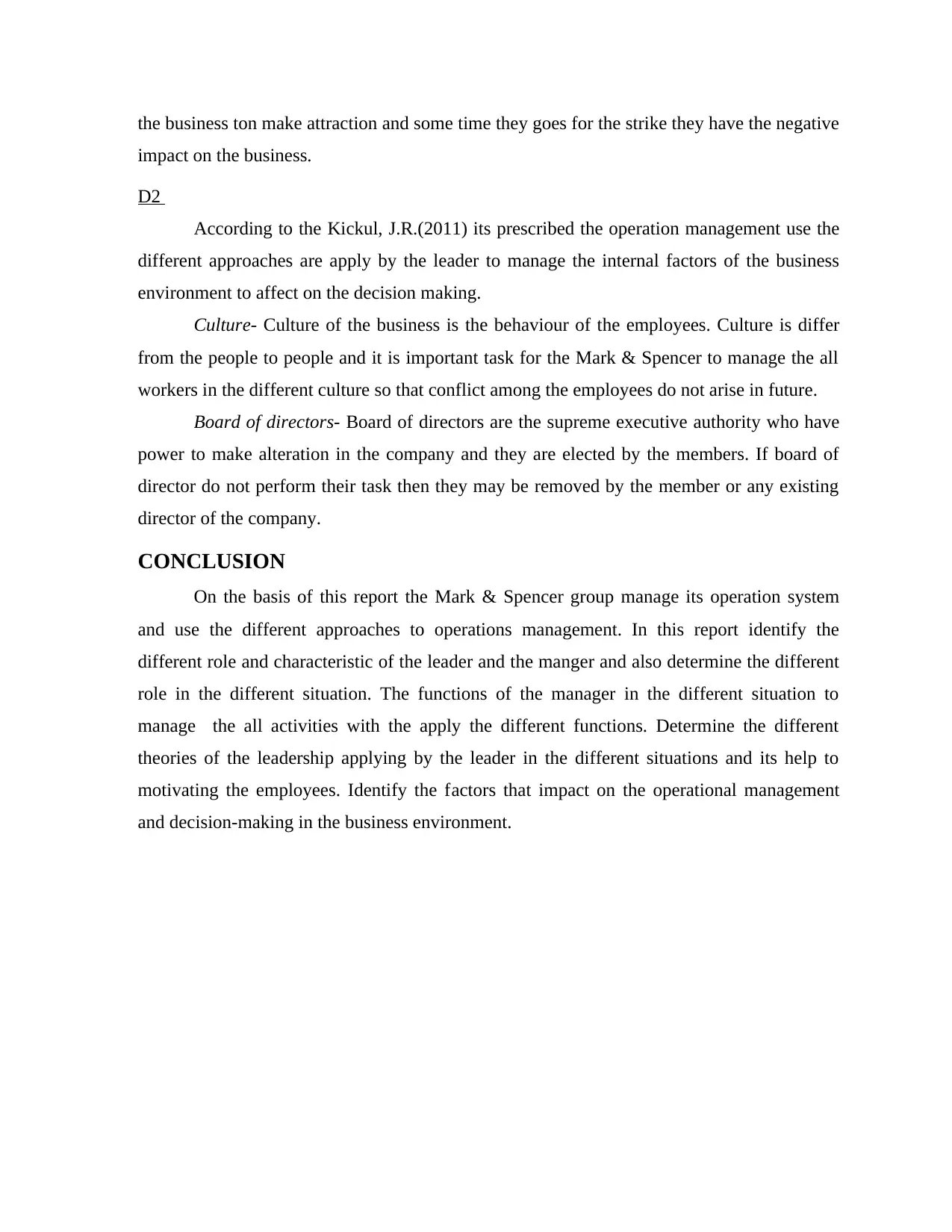
the business ton make attraction and some time they goes for the strike they have the negative
impact on the business.
D2
According to the Kickul, J.R.(2011) its prescribed the operation management use the
different approaches are apply by the leader to manage the internal factors of the business
environment to affect on the decision making.
Culture- Culture of the business is the behaviour of the employees. Culture is differ
from the people to people and it is important task for the Mark & Spencer to manage the all
workers in the different culture so that conflict among the employees do not arise in future.
Board of directors- Board of directors are the supreme executive authority who have
power to make alteration in the company and they are elected by the members. If board of
director do not perform their task then they may be removed by the member or any existing
director of the company.
CONCLUSION
On the basis of this report the Mark & Spencer group manage its operation system
and use the different approaches to operations management. In this report identify the
different role and characteristic of the leader and the manger and also determine the different
role in the different situation. The functions of the manager in the different situation to
manage the all activities with the apply the different functions. Determine the different
theories of the leadership applying by the leader in the different situations and its help to
motivating the employees. Identify the factors that impact on the operational management
and decision-making in the business environment.
impact on the business.
D2
According to the Kickul, J.R.(2011) its prescribed the operation management use the
different approaches are apply by the leader to manage the internal factors of the business
environment to affect on the decision making.
Culture- Culture of the business is the behaviour of the employees. Culture is differ
from the people to people and it is important task for the Mark & Spencer to manage the all
workers in the different culture so that conflict among the employees do not arise in future.
Board of directors- Board of directors are the supreme executive authority who have
power to make alteration in the company and they are elected by the members. If board of
director do not perform their task then they may be removed by the member or any existing
director of the company.
CONCLUSION
On the basis of this report the Mark & Spencer group manage its operation system
and use the different approaches to operations management. In this report identify the
different role and characteristic of the leader and the manger and also determine the different
role in the different situation. The functions of the manager in the different situation to
manage the all activities with the apply the different functions. Determine the different
theories of the leadership applying by the leader in the different situations and its help to
motivating the employees. Identify the factors that impact on the operational management
and decision-making in the business environment.
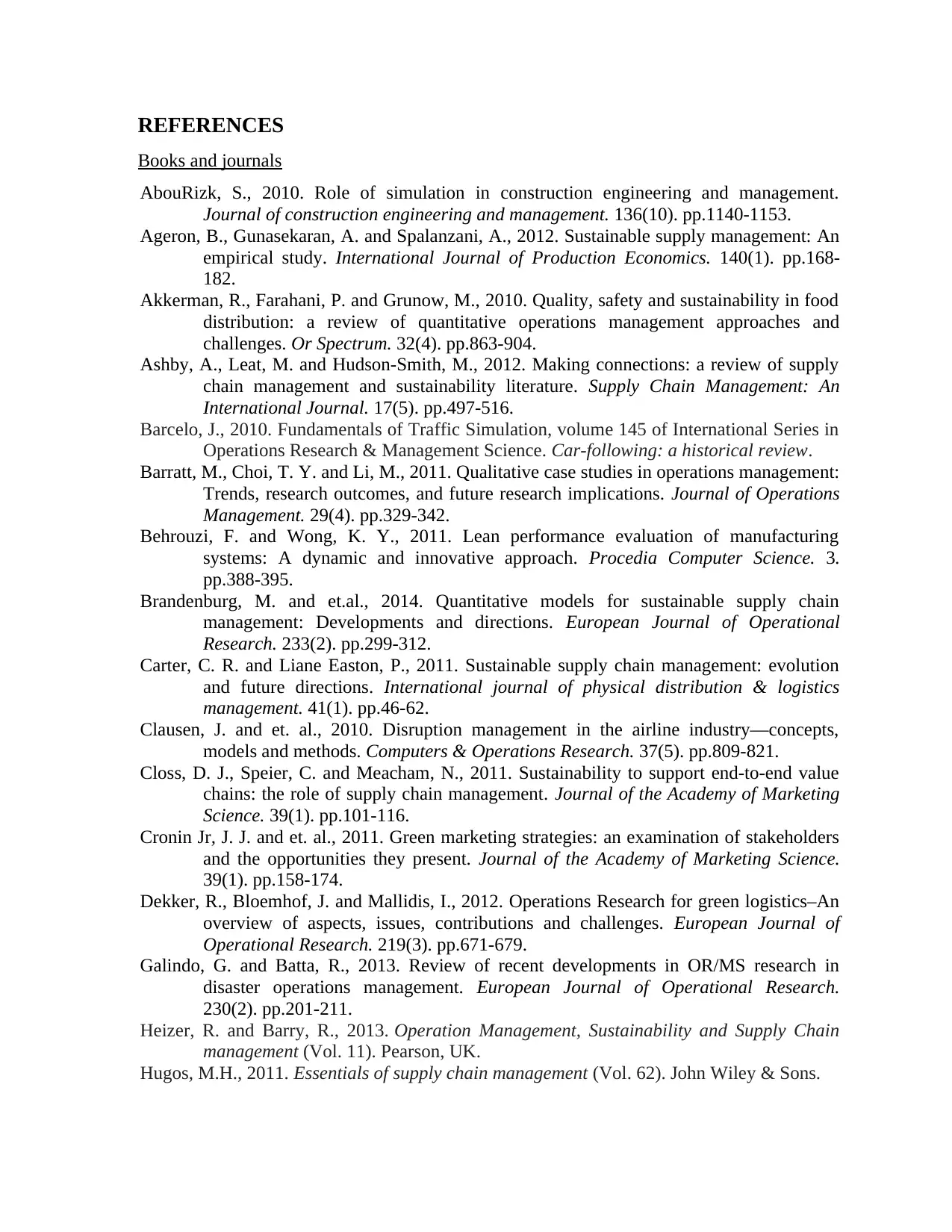
REFERENCES
Books and journals
AbouRizk, S., 2010. Role of simulation in construction engineering and management.
Journal of construction engineering and management. 136(10). pp.1140-1153.
Ageron, B., Gunasekaran, A. and Spalanzani, A., 2012. Sustainable supply management: An
empirical study. International Journal of Production Economics. 140(1). pp.168-
182.
Akkerman, R., Farahani, P. and Grunow, M., 2010. Quality, safety and sustainability in food
distribution: a review of quantitative operations management approaches and
challenges. Or Spectrum. 32(4). pp.863-904.
Ashby, A., Leat, M. and Hudson-Smith, M., 2012. Making connections: a review of supply
chain management and sustainability literature. Supply Chain Management: An
International Journal. 17(5). pp.497-516.
Barcelo, J., 2010. Fundamentals of Traffic Simulation, volume 145 of International Series in
Operations Research & Management Science. Car-following: a historical review.
Barratt, M., Choi, T. Y. and Li, M., 2011. Qualitative case studies in operations management:
Trends, research outcomes, and future research implications. Journal of Operations
Management. 29(4). pp.329-342.
Behrouzi, F. and Wong, K. Y., 2011. Lean performance evaluation of manufacturing
systems: A dynamic and innovative approach. Procedia Computer Science. 3.
pp.388-395.
Brandenburg, M. and et.al., 2014. Quantitative models for sustainable supply chain
management: Developments and directions. European Journal of Operational
Research. 233(2). pp.299-312.
Carter, C. R. and Liane Easton, P., 2011. Sustainable supply chain management: evolution
and future directions. International journal of physical distribution & logistics
management. 41(1). pp.46-62.
Clausen, J. and et. al., 2010. Disruption management in the airline industry—concepts,
models and methods. Computers & Operations Research. 37(5). pp.809-821.
Closs, D. J., Speier, C. and Meacham, N., 2011. Sustainability to support end-to-end value
chains: the role of supply chain management. Journal of the Academy of Marketing
Science. 39(1). pp.101-116.
Cronin Jr, J. J. and et. al., 2011. Green marketing strategies: an examination of stakeholders
and the opportunities they present. Journal of the Academy of Marketing Science.
39(1). pp.158-174.
Dekker, R., Bloemhof, J. and Mallidis, I., 2012. Operations Research for green logistics–An
overview of aspects, issues, contributions and challenges. European Journal of
Operational Research. 219(3). pp.671-679.
Galindo, G. and Batta, R., 2013. Review of recent developments in OR/MS research in
disaster operations management. European Journal of Operational Research.
230(2). pp.201-211.
Heizer, R. and Barry, R., 2013. Operation Management, Sustainability and Supply Chain
management (Vol. 11). Pearson, UK.
Hugos, M.H., 2011. Essentials of supply chain management (Vol. 62). John Wiley & Sons.
Books and journals
AbouRizk, S., 2010. Role of simulation in construction engineering and management.
Journal of construction engineering and management. 136(10). pp.1140-1153.
Ageron, B., Gunasekaran, A. and Spalanzani, A., 2012. Sustainable supply management: An
empirical study. International Journal of Production Economics. 140(1). pp.168-
182.
Akkerman, R., Farahani, P. and Grunow, M., 2010. Quality, safety and sustainability in food
distribution: a review of quantitative operations management approaches and
challenges. Or Spectrum. 32(4). pp.863-904.
Ashby, A., Leat, M. and Hudson-Smith, M., 2012. Making connections: a review of supply
chain management and sustainability literature. Supply Chain Management: An
International Journal. 17(5). pp.497-516.
Barcelo, J., 2010. Fundamentals of Traffic Simulation, volume 145 of International Series in
Operations Research & Management Science. Car-following: a historical review.
Barratt, M., Choi, T. Y. and Li, M., 2011. Qualitative case studies in operations management:
Trends, research outcomes, and future research implications. Journal of Operations
Management. 29(4). pp.329-342.
Behrouzi, F. and Wong, K. Y., 2011. Lean performance evaluation of manufacturing
systems: A dynamic and innovative approach. Procedia Computer Science. 3.
pp.388-395.
Brandenburg, M. and et.al., 2014. Quantitative models for sustainable supply chain
management: Developments and directions. European Journal of Operational
Research. 233(2). pp.299-312.
Carter, C. R. and Liane Easton, P., 2011. Sustainable supply chain management: evolution
and future directions. International journal of physical distribution & logistics
management. 41(1). pp.46-62.
Clausen, J. and et. al., 2010. Disruption management in the airline industry—concepts,
models and methods. Computers & Operations Research. 37(5). pp.809-821.
Closs, D. J., Speier, C. and Meacham, N., 2011. Sustainability to support end-to-end value
chains: the role of supply chain management. Journal of the Academy of Marketing
Science. 39(1). pp.101-116.
Cronin Jr, J. J. and et. al., 2011. Green marketing strategies: an examination of stakeholders
and the opportunities they present. Journal of the Academy of Marketing Science.
39(1). pp.158-174.
Dekker, R., Bloemhof, J. and Mallidis, I., 2012. Operations Research for green logistics–An
overview of aspects, issues, contributions and challenges. European Journal of
Operational Research. 219(3). pp.671-679.
Galindo, G. and Batta, R., 2013. Review of recent developments in OR/MS research in
disaster operations management. European Journal of Operational Research.
230(2). pp.201-211.
Heizer, R. and Barry, R., 2013. Operation Management, Sustainability and Supply Chain
management (Vol. 11). Pearson, UK.
Hugos, M.H., 2011. Essentials of supply chain management (Vol. 62). John Wiley & Sons.
⊘ This is a preview!⊘
Do you want full access?
Subscribe today to unlock all pages.

Trusted by 1+ million students worldwide
1 out of 13
Related Documents
Your All-in-One AI-Powered Toolkit for Academic Success.
+13062052269
info@desklib.com
Available 24*7 on WhatsApp / Email
![[object Object]](/_next/static/media/star-bottom.7253800d.svg)
Unlock your academic potential
Copyright © 2020–2025 A2Z Services. All Rights Reserved. Developed and managed by ZUCOL.




